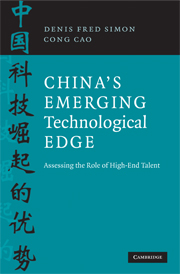32 results
Contributors
-
-
- Book:
- The Cambridge Dictionary of Philosophy
- Published online:
- 05 August 2015
- Print publication:
- 27 April 2015, pp ix-xxx
-
- Chapter
- Export citation
3 - Human resources in science and technology, and their structure and characteristics in China
-
- Book:
- China's Emerging Technological Edge
- Published online:
- 25 January 2011
- Print publication:
- 19 March 2009, pp 57-109
-
- Chapter
- Export citation
5 - Utilization of scientists and engineers in China
-
- Book:
- China's Emerging Technological Edge
- Published online:
- 25 January 2011
- Print publication:
- 19 March 2009, pp 166-211
-
- Chapter
- Export citation
9 - Whither China's talent pool?
-
- Book:
- China's Emerging Technological Edge
- Published online:
- 25 January 2011
- Print publication:
- 19 March 2009, pp 333-346
-
- Chapter
- Export citation
8 - China's talent in key emerging technologies
-
- Book:
- China's Emerging Technological Edge
- Published online:
- 25 January 2011
- Print publication:
- 19 March 2009, pp 284-332
-
- Chapter
- Export citation
Introduction
-
- Book:
- China's Emerging Technological Edge
- Published online:
- 25 January 2011
- Print publication:
- 19 March 2009, pp xviii-xxviii
-
- Chapter
- Export citation
Contents
-
- Book:
- China's Emerging Technological Edge
- Published online:
- 25 January 2011
- Print publication:
- 19 March 2009, pp v-v
-
- Chapter
- Export citation
4 - Higher education and scientists and engineers in the pipeline
-
- Book:
- China's Emerging Technological Edge
- Published online:
- 25 January 2011
- Print publication:
- 19 March 2009, pp 110-165
-
- Chapter
- Export citation
References
-
- Book:
- China's Emerging Technological Edge
- Published online:
- 25 January 2011
- Print publication:
- 19 March 2009, pp 376-396
-
- Chapter
- Export citation
List of Figures and tables
-
- Book:
- China's Emerging Technological Edge
- Published online:
- 25 January 2011
- Print publication:
- 19 March 2009, pp vi-x
-
- Chapter
- Export citation
7 - Supply and demand of science and technology talent in China: key drivers
-
- Book:
- China's Emerging Technological Edge
- Published online:
- 25 January 2011
- Print publication:
- 19 March 2009, pp 254-283
-
- Chapter
- Export citation
2 - China's talent challenge
-
- Book:
- China's Emerging Technological Edge
- Published online:
- 25 January 2011
- Print publication:
- 19 March 2009, pp 22-56
-
- Chapter
- Export citation
1 - Human resources, technological innovation, and economic growth
-
- Book:
- China's Emerging Technological Edge
- Published online:
- 25 January 2011
- Print publication:
- 19 March 2009, pp 1-21
-
- Chapter
- Export citation
Abbreviations
-
- Book:
- China's Emerging Technological Edge
- Published online:
- 25 January 2011
- Print publication:
- 19 March 2009, pp xvi-xvii
-
- Chapter
- Export citation

China's Emerging Technological Edge
- Assessing the Role of High-End Talent
-
- Published online:
- 25 January 2011
- Print publication:
- 19 March 2009
Appendix: Understanding Chinese science and technology human resources statistics
-
- Book:
- China's Emerging Technological Edge
- Published online:
- 25 January 2011
- Print publication:
- 19 March 2009, pp 347-375
-
- Chapter
- Export citation
Frontmatter
-
- Book:
- China's Emerging Technological Edge
- Published online:
- 25 January 2011
- Print publication:
- 19 March 2009, pp i-iv
-
- Chapter
- Export citation
6 - “Brain drain,” “brain gain,” and “brain circulation”
-
- Book:
- China's Emerging Technological Edge
- Published online:
- 25 January 2011
- Print publication:
- 19 March 2009, pp 212-253
-
- Chapter
- Export citation
Index
-
- Book:
- China's Emerging Technological Edge
- Published online:
- 25 January 2011
- Print publication:
- 19 March 2009, pp 397-406
-
- Chapter
- Export citation
Acknowledgements
-
- Book:
- China's Emerging Technological Edge
- Published online:
- 25 January 2011
- Print publication:
- 19 March 2009, pp xi-xv
-
- Chapter
- Export citation



